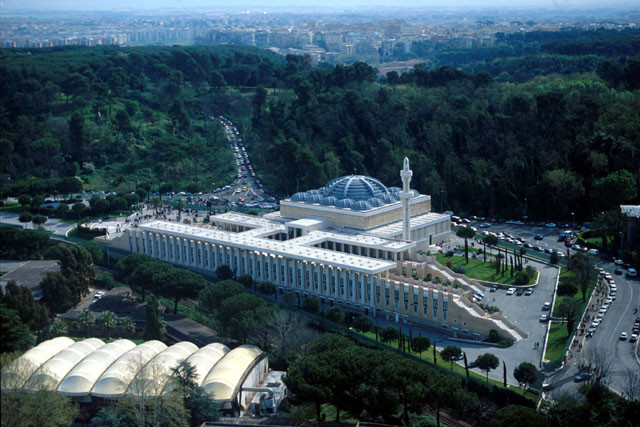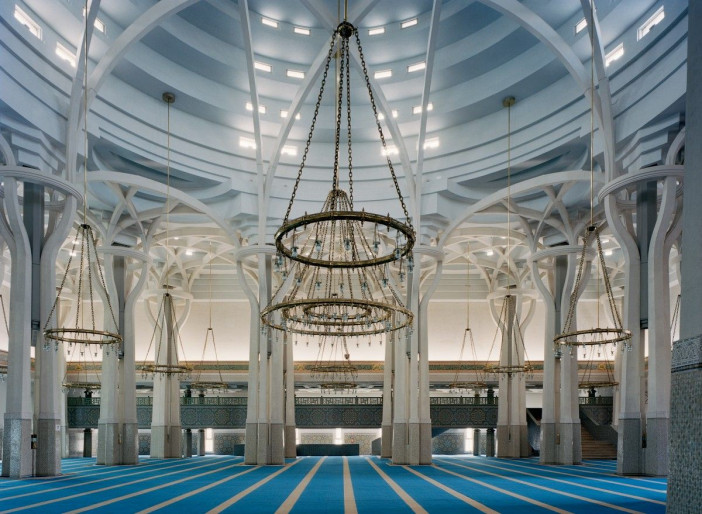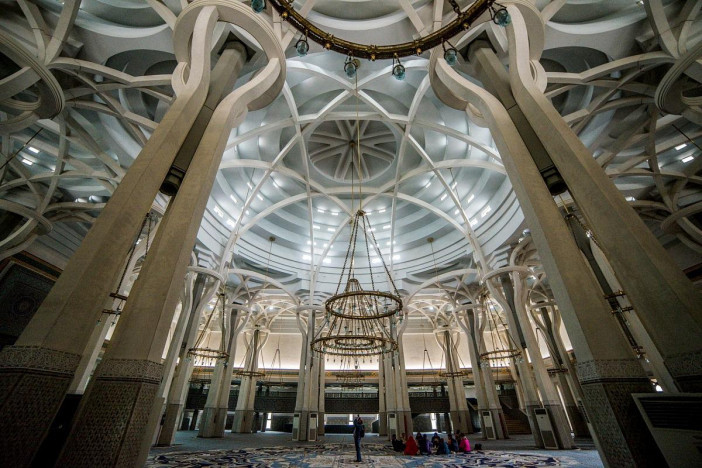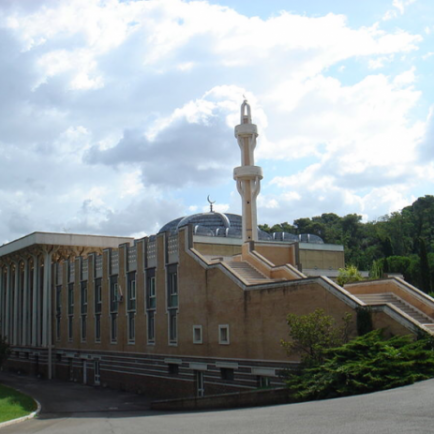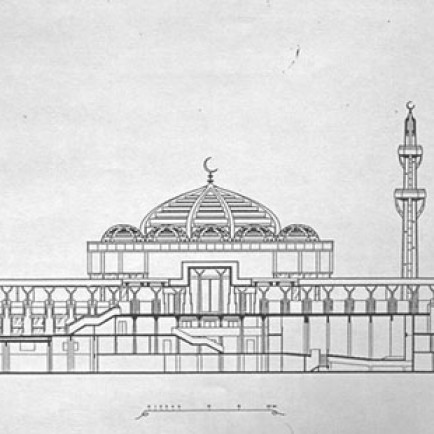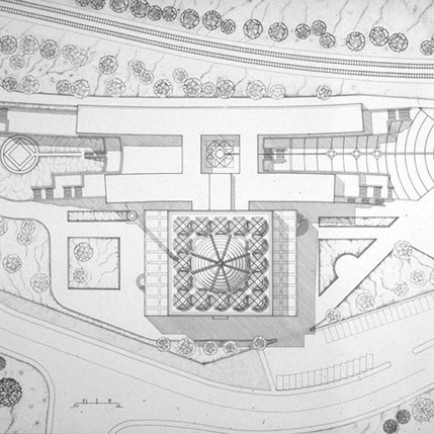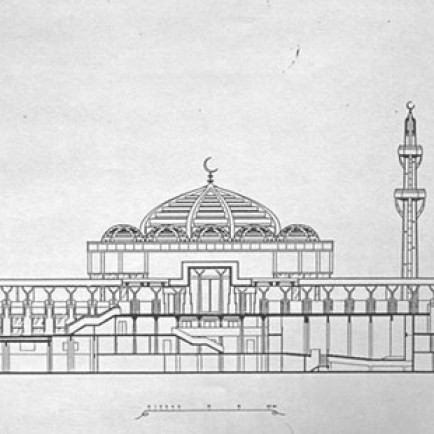Strasbourg Mosque
History
The former mosque, in use from 1982 to 2012, consisted of a converted foie gras factory in the Impasse de mai in the centre of Strasbourg, near the law-courts. It was not the first mosque to be established in Strasbourg. There have been mosques in the city since 1967 and there are now over twenty.
Urban and Architectural
The functional requirements for the design of the center included designing a prayer area which would accommodate 2'500 worshippers, and which would be served by ablution areas. In addition, the design was to include a smaller prayer hall which would accommodate 150 worshippers, an educational section containing a library and classrooms, a conference auditorium for 400 people, an exhibition area, and two residential apartments, one for the imam of the mosque and the other for visitors.
In plan, the complex consists of two parts. The first is a rectangular prayer hall measuring about 60 x 40 m with the longer sides facing the qibla (the Southeast). The second part approximates the shape of an "H" and houses the remaining functions of the complex except for the ablution facilities, which are located beneath the prayer hall. A water channel runs along the longitudinal axis of the H-shaped mass and connects two pools, one located in the centre of the mass and another to the Northeast. The longest side of the H-shaped mass, which faces the Northwest, curves away from the complex and toward the city, while the other long side of the H-shaped mass curves toward the prayer hall. The minaret is located southwest of the prayer hall, close to where the H-shaped mass and the prayer hall meet. The prayer hall is raised 8 metres above ground level, with the ablution area occupying part of the volume underneath. The space of the prayer hall contains two symmetrically arranged gallery floors that run perpendicular to the qibla wall. Together, the galleries provide a space for female worshippers about a fourth of the size of the main prayer hall located below them. The prayer hall is articulated by a large central dome with a diameter of over 20 metres. 16 smaller domes surround the large central one. All of the domes are covered with lead and each is articulated with ribs meeting at its apex.
Description
The Mosque and Islamic Cultural Center is situated in Parioli, Rome, Italy, is the largest mosque in the western world in terms of land area. It has an area of 30,000 m2 and can accommodate more than 12,000 people. The building is located in the Acqua Acetosa area, at the foot of the Monti Parioli, north of the city. It is also the seat of the Italian Islamic Cultural Centre.
The Mosque and Islamic Cultural Center is intended to serve the growing number of Muslims that have moved to Rome. The mosque is the only one in Rome and the complex is considered one of the major monuments built in the city in the past few decades. It has become well known outside Rome and Italy as a result of the considerable coverage it has received in a number of international publications.
In addition to being a meeting place for religious activities, it provides cultural and social services variously connecting Muslims together. It also holds teachings, wedding ceremonies, funeral services, exegesis, exhibitions, conventions, and other events, despite the location of the mosque is a relatively small percentage of Muslim zone.
The current Imam of the mosque is the Sheikh Salah Ramadan Elsayed; Al-Azhar University graduate and former Democratic Party deputy Khalid Chaouki is in charge of the Cultural Centre, to which the management of the complex is entrusted. Former Imams include:
1983–1993: Muhammad Nur al-Din Isma'il
1993–2006: Mahmud Hammad Shwayta
2007–2010: Ala' al-Din Muhammad Isma'il al-Ghobashi
2010–2013: Ahmed Al-Saqqa
2013–2016: Muhammad Hassan Abdulghaffar
References
https://en.wikipedia.org/wiki/Mosque_of_Rome
https://media.halaltrip.com/mosque/380241442441368_1442441404.PNG
https://mosqpedia.org/img/cache/largeimage/O70VPMMBLUThGOzMHZDOKrtia6ka8fG6gZPtiYrz
https://i.pinimg.com/originals/12/a3/48/12a348266a3f70ee4a28f44ce1cf2c3a.jpg
https://image.slidesharecdn.com/casestudyofislamiccentres-171112203904/95/case-study-of-islamic-center-of-rome-faisal-mosque-suleiman-mosque-turkey-6-638.jpg?cb=1510519617
Details
Location
6 Rue Averroes, 67000 Strasbourg, France
Worshippers
1200
Architect Name
Year of Build
2012
Drawings
Map
History
The former mosque, in use from 1982 to 2012, consisted of a converted foie gras factory in the Impasse de mai in the centre of Strasbourg, near the law-courts. It was not the first mosque to be established in Strasbourg. There have been mosques in the city since 1967 and there are now over twenty.
Urban and Architectural
The functional requirements for the design of the center included designing a prayer area which would accommodate 2'500 worshippers, and which would be served by ablution areas. In addition, the design was to include a smaller prayer hall which would accommodate 150 worshippers, an educational section containing a library and classrooms, a conference auditorium for 400 people, an exhibition area, and two residential apartments, one for the imam of the mosque and the other for visitors.
In plan, the complex consists of two parts. The first is a rectangular prayer hall measuring about 60 x 40 m with the longer sides facing the qibla (the Southeast). The second part approximates the shape of an "H" and houses the remaining functions of the complex except for the ablution facilities, which are located beneath the prayer hall. A water channel runs along the longitudinal axis of the H-shaped mass and connects two pools, one located in the centre of the mass and another to the Northeast. The longest side of the H-shaped mass, which faces the Northwest, curves away from the complex and toward the city, while the other long side of the H-shaped mass curves toward the prayer hall. The minaret is located southwest of the prayer hall, close to where the H-shaped mass and the prayer hall meet. The prayer hall is raised 8 metres above ground level, with the ablution area occupying part of the volume underneath. The space of the prayer hall contains two symmetrically arranged gallery floors that run perpendicular to the qibla wall. Together, the galleries provide a space for female worshippers about a fourth of the size of the main prayer hall located below them. The prayer hall is articulated by a large central dome with a diameter of over 20 metres. 16 smaller domes surround the large central one. All of the domes are covered with lead and each is articulated with ribs meeting at its apex.
Description
The Mosque and Islamic Cultural Center is situated in Parioli, Rome, Italy, is the largest mosque in the western world in terms of land area. It has an area of 30,000 m2 and can accommodate more than 12,000 people. The building is located in the Acqua Acetosa area, at the foot of the Monti Parioli, north of the city. It is also the seat of the Italian Islamic Cultural Centre.
The Mosque and Islamic Cultural Center is intended to serve the growing number of Muslims that have moved to Rome. The mosque is the only one in Rome and the complex is considered one of the major monuments built in the city in the past few decades. It has become well known outside Rome and Italy as a result of the considerable coverage it has received in a number of international publications.
In addition to being a meeting place for religious activities, it provides cultural and social services variously connecting Muslims together. It also holds teachings, wedding ceremonies, funeral services, exegesis, exhibitions, conventions, and other events, despite the location of the mosque is a relatively small percentage of Muslim zone.
The current Imam of the mosque is the Sheikh Salah Ramadan Elsayed; Al-Azhar University graduate and former Democratic Party deputy Khalid Chaouki is in charge of the Cultural Centre, to which the management of the complex is entrusted. Former Imams include:
1983–1993: Muhammad Nur al-Din Isma'il
1993–2006: Mahmud Hammad Shwayta
2007–2010: Ala' al-Din Muhammad Isma'il al-Ghobashi
2010–2013: Ahmed Al-Saqqa
2013–2016: Muhammad Hassan Abdulghaffar


